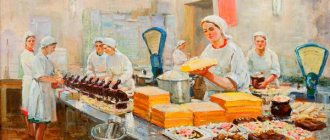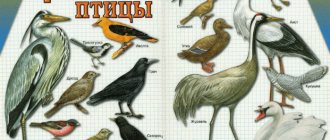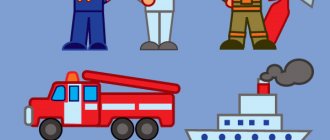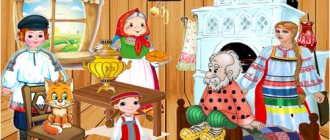Summary of an open speech therapy lesson on coherent speech on the topic “Wild animals of our forests”
Goal: To clarify and systematize students’ knowledge on the lexical topic “Wild animals of our forests.”
Tasks
Educational:
- activation and enrichment of vocabulary on the lexical topic “Wild animals of our forests”
- practice forming complex adjectives
- teach to name words-signs
Educational:
- develop the ability to listen carefully to the teacher and peers
- cultivate respect for nature
- develop interest in the content of the lesson
- education of hard work
Corrective:
- correction of agrammatic phrase construction
- overcoming speech negativism
- development of articulation (improving the mobility of the organs of the articulatory apparatus)
- development of speech breathing
- development of fine motor skills
- development of spatial concepts
- development of coherent speech skills
- development of children's thinking based on descriptive riddles
Progress of the lesson:
Organizing time.
- Hello guys. Today in class we will have to complete many different tasks. To successfully cope with them, we need to be properly prepared.
Therefore, we listen to me carefully and work diligently.
- Let's repeat the rules that we use in speech development classes.
- Speak slowly, without rushing. Pronounce all sounds clearly.
Breathing exercises
- Guys, now we will sing the vowel sounds: A, O, U, I
Remember that we inhale through the nose, exhale through the mouth
Speech gymnastics
Pure talk
Su-su-su - we saw a fox Zha-zha-zha - the hedgehog has needles. La-la-la - a squirrel lived in the forest. Xia-xia-xia - we saw a moose in the thicket. Olk-olk-olk - a wolf spends the winter in the den. Sy-sy-sy - the bunny jumps from the fox. After all, after all, after all, the bear sleeps in winter
Lesson topic message
- Guys, now look at the board and tell me which animal is the odd one out? (The cow is extra.)
- Why? (Because all animals are wild, but a cow is a domestic animal.)
- Well done.
— You probably already guessed who we’ll talk about in class today? (Yes. About wild animals.)
— That's right, about wild animals.
- Why are they called wild? (Because they live in the forest).
- What is another name for animals? (Beasts)
Work on a lexical topic
- Guys, let's name the cubs of these animals. I throw the ball and name the animal. You name the baby animal and throw the ball back to me. Who's the squirrel's baby? The hare? The fox? The wolf? The bear? At the moose? The hedgehog? I open the pictures on the board and check with the children’s answers - Guys, let’s now draw wild animals and describe them. What are they? - Bear (what?) Brown, huge, shaggy, clubfooted, clumsy, strong. - Hare (what?) Small, nimble, white, long-eared, fluffy. - Fox (what?) Sly, red-haired, - Hedgehog (what?) Prickly, small - Squirrel (what?) Agile, fluffy, flickering
In the next task you need to complete sentences and say words with the opposite meaning.
The elk is big, and the hare... (what?) is small. The squirrel is weak, and the wolf... (what?) is strong. The wolf has a long tail, and the bear has... (what?) is short. The fox is a predatory animal, and the hare... (what?) is a herbivore.
Now guys look at the picture and name whose tail is. - Whose tail does the hare have? (hare) - Whose tail does the fox have? (fox) - Whose tail does the wolf have? (wolf)
Finger gymnastics “Squirrel sitting on a cart”
A squirrel sits on a cart. (Clenching and unclenching the fingers of both hands) She sells nuts: (Make a circle with the index finger and thumb) To the mustachioed bunny, (Finger exercise “Hare”) To the thick-fifted bear, (Knock on the table with the edge of the palm) To the gray wolf cub, (Finger exercise “Wolf”) To the prickly hedgehog. (Finger exercise “Hedgehog”)
Working on difficult words
- Now let’s name some difficult words. A hare has long ears - long-eared. A hedgehog has a sharp nose - pointed-nosed. A hare has slanted eyes - cross-eyed. A bear has a short tail - short-tailed.
Orientation in space
- Guys, repeat after me. Left and right build cities, Left and right drive trains, Left and right know how to sew and darn, Left and right know how to clap loudly.
Raised your left hand, raised your right hand. The eyes looked up and down. We touched our left ear with our right hand and covered our right eye with our left hand. We touched our right ear with our left hand and covered our left eye with our right hand.
Arrange the animals in relation to the tree: squirrel on the right, hare on the left, bear at the top, wolf at the bottom.
Compiling a story-description
- Guys, now let's tell you where wild animals live? Where does the squirrel live? (The squirrel lives in a hollow) Where does the fox live? (The fox lives in a hole) Where does the hare live? (The hare lives under a bush) Where does the wolf live? (The wolf lives in a den) Where does the bear live? (The bear lives in a den) Where does the hedgehog live? (The hedgehog lives under the leaves) Where does the moose live? (The moose lives in the forest)
- Guys, now we will try to compose a short description story about animals. For example, let's make a story about a squirrel. Where does the squirrel live? The squirrel lives in a hollow. What does a squirrel eat? The squirrel eats nuts and mushrooms. So is the squirrel a carnivore or a herbivore? Herbivore Name the baby squirrels? Baby squirrels. What does a squirrel look like? The squirrel has red fur, small paws, a long fluffy tail, and tassels on its ears.
- Now I will give you cards with animals, and you will write your own description story. The speech therapist hands out cards with animals (bear, fox, hare, wolf, hedgehog) And now, in turn, everyone describes their animal. -Okay, well done.
-Guys, now guess the riddles about wild animals
Puzzles
Not a lamb or a cat, wears a fur coat all year round. A gray fur coat for summer, a different color for winter. (Hare)
A lush tail sticks out from the top, What is this strange little animal? Well, of course, this is... (Squirrel).
Cunning cheat, Red head. A fluffy tail is a beauty. Who is this? (Fox)
In a dense forest under a fir tree, showered with leaves, lies a bag of needles, prickly and alive. (Hedgehog)
Who walks around angry and hungry in the cold winter? (Wolf)
The owner of the forest wakes up in the spring, and in winter, to the howl of a blizzard, he sleeps in a snowy hut. (Bear)
Summary of the lesson (reflection)
Guys, tell me what animals we studied in class today? That's right, wild animals. Why are they called wild? Okay, well done. So our lesson with you has come to an end. Did you guys like it?
Gorevaya Olga Andreevna teacher-speech therapist, MKDOU No. 335 combined type, Novosibirsk
Summary of educational activities for speech development in the senior group “Wild Animals of Russia”
Program objectives: 1. Continue to introduce children to the wild animals of our country 2. Clarify the body parts of animals 3. Develop the ability to form complex adjectives 4. Develop the ability to name words with the same root 5. Practice naming an animal in combination with the word “many” 6. Cultivate careful attitude towards animals
Lesson progress:
Org.
moment. On the easel there are pictures of wild animals of Russia.
Educator: Guys, look at the pictures, who do you see? Children: Fox, wolf, bear, hare, moose, hedgehog, squirrel, wild boar, badger. Educator: That's right, guys, who is this? How can they all be called in one word? Children: Animals Educator: You are right, these are animals. Tell me where do these animals live? Children: In the forest Educator: So what are they like? Children: Wild Educator: Yes, these are wild animals. They live on the territory of our country. These are wild animals of Russia. Let's imitate them a little and perform articulatory gymnastics. Articulation gymnastics 1. “Squirrel” (the mouth is closed, the thin tongue pushes first in one direction, then the other, resting on the cheeks) 2. “Bunny” (the upper lip is pulled up so that the upper teeth are visible. The lower lip is pressed to the lower teeth. Hold for 10 seconds) Educator: Guys, you and I have different moods: both good and bad. Do you think it can change in animals? Children offer answer options Educator: Let's do the exercise Exercise “Animals” Using facial expressions they depict how the wolf is angry, the hare is shaking with fear, the squirrel is worried, the fox is happy. Educator: Do you like animals? Children: Yes Educator: Call them affectionately Game “Call them affectionately” (hedgehog - hedgehog, squirrel - squirrel, hare - bunny, etc.) Educator: Well done! I want to tell you a little about the hedgehog. A hedgehog is a wild animal that lives in the forest. It has prickly needles on its back. When he is afraid, he curls up into a ball. He is a predator and eats mice. It happens that people take a hedgehog home and feed it milk. Although the hedgehog is small, it walks noisily. Let's stomp along with the hedgehog. Finger gymnastics “Hedgehog” On a dry forest path - alternately hitting fist on fist and palm on palm.
Top - top - top - stomp your feet.
They tap their fists on the table one by one.
A gray hedgehog, covered in needles, walks and wanders along the paths.
They hit fist against fist and palm against palm.
Looking for berries and mushrooms for their son and daughter.
alternately connect the fingertips of both hands with the thumb Educator: Now, stand on your feet, imagine that we are wild animals Physical exercise “Wild Animals”
On a hot day, along a forest path, the animals went to a watering hole.
(Children walk in a circle, one after another)
A moose calf stomped behind the mother elk,
(They walk, stomping loudly)
A little fox crept behind the mother fox,
(They walk stealthily)
A hedgehog rolled behind the mother hedgehog,
(They move in a deep squat)
Behind the mother bear a bear cub was walking,
(They move in a deep squat)
The squirrel cubs were galloping after the mother squirrel,
(They were jumping on their toes, with their arms bent in front of the chest)
Behind the mother-hare were slanting hares,
(They were jumping, making “ears” from their palms)
The she-wolf led the wolf cubs.
(Walk on all fours)
All mothers and children want to get drunk.
(They walk on all fours) Educator: Excellent. Do you know that two words can be made into one? Shall we try? Children: Yes Game “Name a new word” (a bear has thick paws - a bear is thick-footed, a hare has long ears - a hare is long-eared, a wolf has sharp teeth - a wolf is sharp-toothed, etc.) Educator: Look at the pictures, what parts of the body does the wolf have? animals? 1 child:
the wolf has a head, muzzle, fangs, teeth, nose, eyes, ears, paws, tail, mouth, claws, torso, neck
2 child:
the bear has a head, muzzle, teeth, nose, eyes, ears, paws , tail, mouth, claws, torso, neck
Educator: We have wild animals depicted on our easel. A lot of them. Game “One - many” (one fox - many foxes, one hare - many hares, one hedgehog - many hedgehogs.) Educator: Well done, guys. Someone is knocking on our door. The postman enters.
Hello, guys, I was told to give you a parcel from the squirrel.
Delivers the parcel. Educator: Guys, what is there? They open the package, there are nuts and a note “Bon appetit! Sincerely, squirrel"
We recommend watching:
Notes for a lesson on speech development in the senior group: Special-purpose transport Notes for educational activities on the formation of a holistic picture of the world in children in the middle group with visual impairments. Di Summary of a lesson on speech development for children in the senior group of preschool educational institutions. Summary of a lesson on speech development in the senior group. Nosov "Gardeners"
Similar articles:
Summary of a lesson on speech development in the senior group. Compiling a descriptive story based on a painting
Summary of a lesson on speech development in the senior group. Reading works of fiction
Summary of a lesson on speech development in the senior group. Retelling of a work of art. Charushin "Sparrow"
Summary of a lesson on ecology in the senior group of kindergarten on the topic “Man and Nature”
Lesson on emotional development in the senior group




